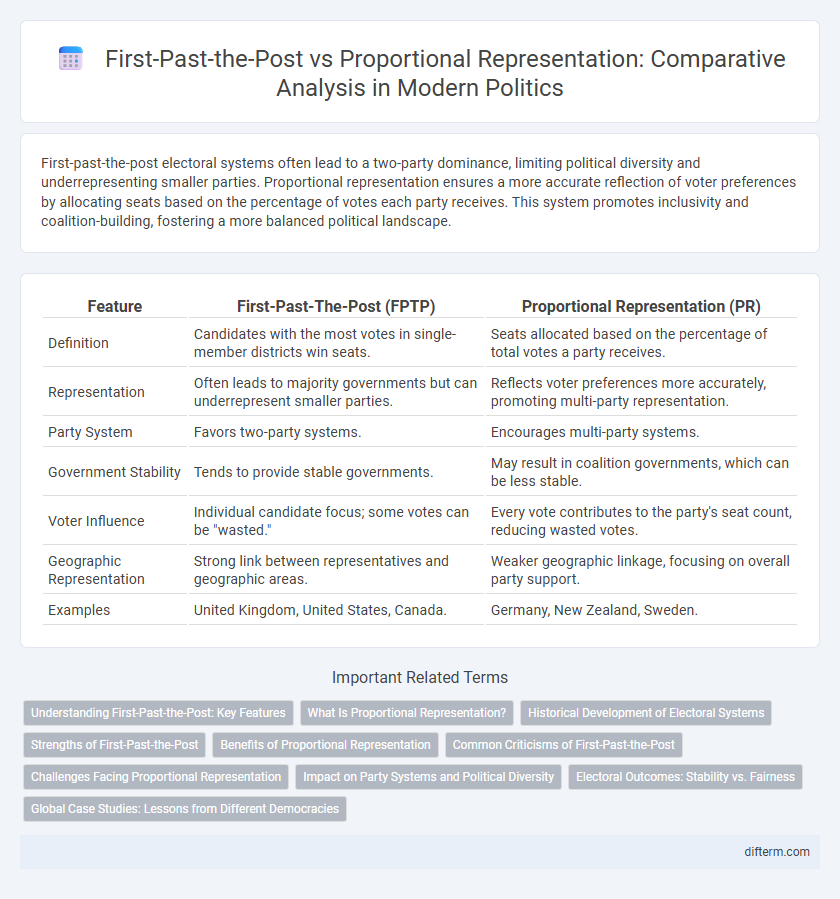First-past-the-post electoral systems often lead to a two-party dominance, limiting political diversity and underrepresenting smaller parties. Proportional representation ensures a more accurate reflection of voter preferences by allocating seats based on the percentage of votes each party receives. This system promotes inclusivity and coalition-building, fostering a more balanced political landscape.
Table of Comparison
| Feature | First-Past-The-Post (FPTP) | Proportional Representation (PR) |
|---|---|---|
| Definition | Candidates with the most votes in single-member districts win seats. | Seats allocated based on the percentage of total votes a party receives. |
| Representation | Often leads to majority governments but can underrepresent smaller parties. | Reflects voter preferences more accurately, promoting multi-party representation. |
| Party System | Favors two-party systems. | Encourages multi-party systems. |
| Government Stability | Tends to provide stable governments. | May result in coalition governments, which can be less stable. |
| Voter Influence | Individual candidate focus; some votes can be "wasted." | Every vote contributes to the party's seat count, reducing wasted votes. |
| Geographic Representation | Strong link between representatives and geographic areas. | Weaker geographic linkage, focusing on overall party support. |
| Examples | United Kingdom, United States, Canada. | Germany, New Zealand, Sweden. |
Understanding First-Past-the-Post: Key Features
First-past-the-post (FPTP) is an electoral system where the candidate with the most votes in a single-member district wins the seat, often leading to a winner-takes-all outcome. This system tends to favor larger parties and can result in disproportional representation relative to the total vote share. Its simplicity and tendency to produce stable single-party governments contrast with proportional representation systems that allocate seats based on overall vote percentages.
What Is Proportional Representation?
Proportional representation (PR) is an electoral system designed to allocate seats in a legislature in direct proportion to the number of votes each party receives, ensuring a more accurate reflection of voter preferences compared to first-past-the-post (FPTP). Unlike FPTP, where the candidate with the most votes wins a single-member district regardless of overall vote share, PR systems often use multi-member districts or party lists to distribute seats fairly among parties. Countries such as Germany, Sweden, and New Zealand employ proportional representation to promote diverse political representation and reduce the dominance of major parties.
Historical Development of Electoral Systems
First-past-the-post (FPTP) electoral systems originated in England during the Middle Ages, evolving from simple plurality voting in single-member districts that emphasized clear local representation. Proportional representation (PR) emerged in the late 19th century, introduced primarily in European countries to address the limitations of winner-take-all systems and to better reflect diverse political preferences in legislatures. Historical developments reveal that while FPTP reinforced two-party dominance, PR systems facilitated multiparty coalitions and broader voter inclusion, significantly influencing political stability and governance models globally.
Strengths of First-Past-the-Post
First-past-the-post (FPTP) electoral systems deliver clear and decisive government outcomes by awarding victory to the candidate with the most votes, thereby preventing fragmented parliaments. This system tends to promote stable majority governments, enhancing political accountability and reducing the likelihood of coalition complexities found in proportional representation (PR) frameworks. FPTP also encourages a strong link between elected representatives and geographic constituencies, facilitating direct voter engagement and local issue representation.
Benefits of Proportional Representation
Proportional representation ensures that election results more accurately reflect the diversity of voter preferences by allocating seats in proportion to the percentage of votes each party receives. This system promotes fairer representation for smaller parties and minority groups, enhancing political inclusivity and reducing the likelihood of wasted votes. It also encourages coalition-building and consensus politics, which can lead to more stable and representative governance.
Common Criticisms of First-Past-the-Post
First-past-the-post (FPTP) voting often leads to disproportionate election outcomes where a party can win a majority of seats without a majority of the popular vote, undermining fair representation. This system frequently marginalizes smaller parties and minority groups, as their votes translate poorly into legislative seats, reducing political diversity. Moreover, FPTP tends to encourage tactical voting and fosters a two-party dominance, limiting voter choice and reducing overall democratic efficacy.
Challenges Facing Proportional Representation
Proportional representation systems often face challenges such as fragmented legislatures, making coalition governments difficult to form and potentially unstable. The complexity of vote counting and seat allocation can reduce transparency and voter understanding, impacting public trust. Smaller parties may gain disproportionate influence, leading to policy gridlock and challenges in decisive governance.
Impact on Party Systems and Political Diversity
First-past-the-post electoral systems tend to favor a two-party system, often marginalizing smaller parties and limiting political diversity. Proportional representation increases party representation by allocating seats based on vote share, promoting multiparty systems and enhancing political pluralism. This diversity leads to coalition governments, encouraging broader policy debates and more inclusive governance.
Electoral Outcomes: Stability vs. Fairness
First-past-the-post (FPTP) systems often produce stable governments by awarding clear majorities, reducing the likelihood of coalition instability. Proportional representation (PR) enhances fairness by aligning seat distribution closely with the popular vote, reflecting diverse political preferences more accurately. Electoral outcomes under FPTP tend to favor larger parties, whereas PR promotes multiparty representation and coalition governance.
Global Case Studies: Lessons from Different Democracies
Countries employing first-past-the-post (FPTP) like the United States and United Kingdom often face challenges such as disproportionality in seat allocation and underrepresentation of smaller parties. In contrast, nations with proportional representation systems, including Germany and New Zealand, tend to achieve more equitable representation and coalition governments reflecting diverse political views. Analysis of these global case studies reveals that electoral systems significantly influence party dynamics, voter engagement, and governance stability.
first-past-the-post vs proportional representation Infographic

 difterm.com
difterm.com